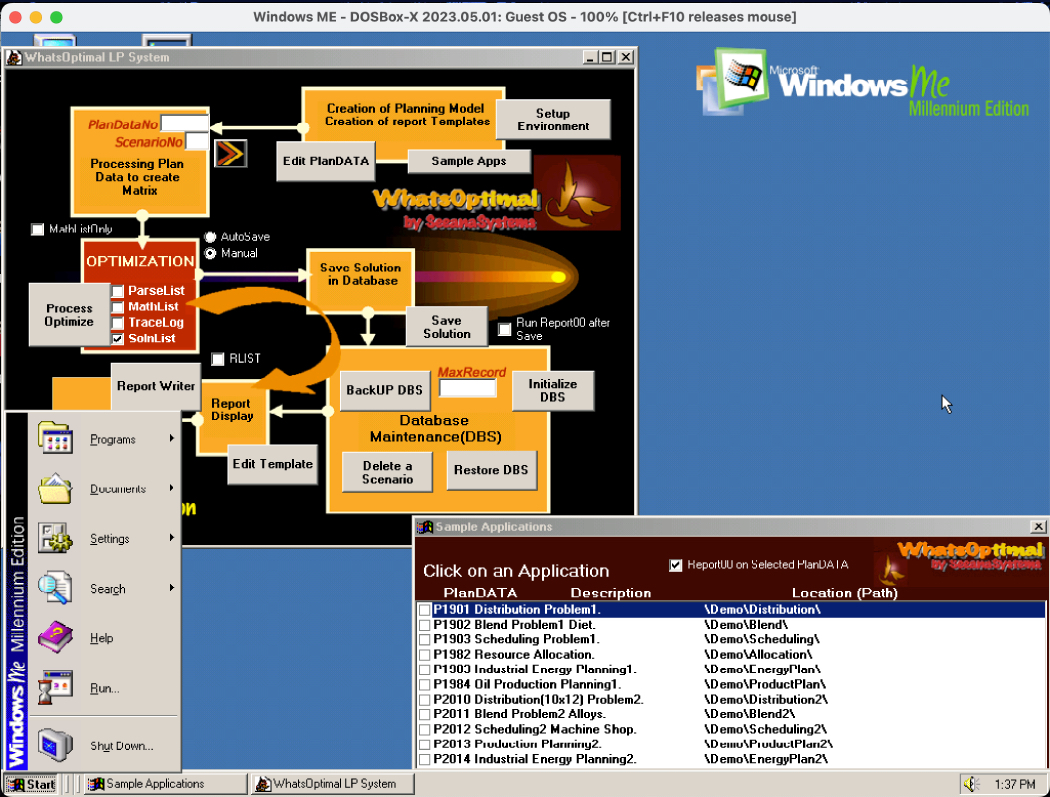 WhatsOptimal, in DosBox-X
WhatsOptimal, in DosBox-X 
Created in 2004, as an upgrade to the old BestPlan created in 1981 to run on Windows-PC.
 WhatsOptimal, in DosBox-X
WhatsOptimal, in DosBox-X 
Created in 2004, as an upgrade to the old BestPlan created in 1981 to run on Windows-PC.
More Information in Facebook
 , formerly Rosetta Systems
, formerly Rosetta Systems
with WindowsME(stripped down, just to demonstrate WhatsOptimal)
DosBox-X hard-disk imagefile for DosBox-X:


| WhatsOPtimal Mission Statement: Help create
awareness of linear optimization among young students by providing a simple
effective method of performing computer based mathematical analysis through
linear programming. Unicode capable, making WhatsOP available in 30 languages for the worldwide students. WhatsOP
helps students understand the concept of choosing between alternative uses of
resources. These decisions are designed to either maximize the profits or to
minimize cost. WhatsOP is an economic planningWhatsOPtimal Mission Statement: Help create awareness of linear optimization among young students by providing a simple effective method of performing computer based mathematical analysis through linear programming. Unicode capable, making WhatsOP available in 30 languages for the worldwide students. WhatsOP helps students understand the concept of choosing between alternative uses of resources. These decisions are designed to either maximize the profits or to minimize cost. WhatsOP is an economic planning system designed to be easy to use and easy to understand. It is completely self-contained for use in a Windows PC planning environment. UNIQUE CONCEPT OF MODELING: WhatsOP uses a unique concept of mathematical modeling, which eliminates the need for a mathematician-analyst to setup a planning model. The model in WhatsOP is not represented through mathematical equations and relations, (although the capability to do so is fully supported) but rather through material flow representations where a material accumulates cost and value-add as the material moves from production, distribution and the market place. This flow of the material and the cost it accumulates is the input model for WhatsOP. This is the reason why new students will find the system appealing. The recipe-like representations are WhatsOP's suggested modeling procedure. But the student will see the corresponding mathematical formulation of the problem, another advantage of the system as a training tool. An economic plan usually can be best represented by a material flow diagram as the product moves from production, distribution and the marketplace. The product will accumulate cost through raw materials, services, other ingredients, energy cost and storage-transportation expenses. Raw materials, resources, services, storage, transportation and time availability of machinery, processes and methods will all be consumed and/or shared by the evolving product/or products. With this literal description of how a product is produced, distributed and sold, the complex and technical disciplines needed to use mathematical modeling systems are eliminated. WhatsOP also simplifies the complexity of analyzing multiple scenario (what-if) analysis conveniently for the student. The student can produce a report which shows all the production volumes and cost for all the scenarios (what-if) analyses all in one report page. This is accomplished through a specially tailored database management system with a template-driven report writing capability. All reports and displays are created through templates, and presented using the supplied text editor Notepad++. SUMMARY: Is WhatsOP and its solution mathematically accurate to be usefull to students of linear algebra, already exposed to more complex methods of mathematical modeling? Maybe NOT, and some professors may comment that it is a simple “math toy”. |